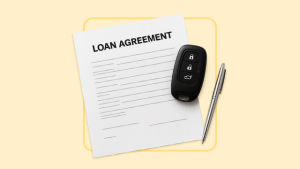AsiaVision/GettyImages; Illustration by Hunter Newton/Bankrate
Key takeaways
- The interest rate and loan amount heavily influence loan costs.
- A short repayment term can lower interest, but long terms have manageable payments.
- Use a calculator to compare loan costs before settling on a loan.
Finding the cash to cover the cost of running a business is a common issue among business owners. According to the Federal Reserve’s 2025 Report on Employer Firms, 56 percent of firms reported struggling to pay operating expenses and 51 percent had to navigate uneven cash flow issues in 2025.
To help with financial issues like these, many business owners apply for a business loan. But business loans aren’t free. You’ll need to consider the cost of taking out a business loan to determine if it’s the best step for your business. Costs like origination fees, accrued interest and additional fees can add up to increase business loan costs.
Know the factors that impact loan costs to find the best business loan. Consider loan terms, interest rate, and loan type as you calculate the potential cost of a business loan.
1. Interest rate
The interest rate is the price you pay to borrow money, usually calculated as a percentage of the amount you are borrowing.
Many people are quoted an annual percentage rate (APR) when applying for a loan. APR factors in other fees that make up your payment. While you may have an interest rate of 5 percent, for example, your total APR could be 5.25 percent. That total means you’re paying an additional quarter percentage point in fees.
Interest rates can vary widely with different kinds of loans or credit levels. Here’s a look at the typical range of interest rates for different loans:
What influences interest rates?
Your exact interest rate depends on many factors, including the type of loan, your collateral and your personal and business credit history. It can also depend on the prime rate, which is an interest rate banks use as a baseline for setting rates for different borrowers. Lenders offer the lowest interest rates to prime borrowers with the strongest credit and financial picture.
SBA loans come with capped interest rates that help make them more affordable than other types of business loans. Types of SBA loans include: SBA 7(a) loans, SBA 504 loans and SBA microloans.
2. Factor rates
Some loans might charge interest as a factor rate, which uses a decimal amount multiplied by the entire loan amount. You may see factor rates used for business loans accessible to borrowers with bad credit, such as lines of credit and merchant cash advances.
You typically pay the entire loan amount plus factor rate, whether or not you repay the loan early. Factor rates are known for converting to high interest rates, so compare these loans carefully with other loans to make sure you’re getting the best deal.
Should you avoid loans with factor rates?
Loans with factor rates typically have higher fees than traditional business loans, but they are more accessible to bad credit borrowers. Convert the factor rate to an annual interest rate to determine how much the loan will cost. This cost won’t include any additional fees, so consider these in your calculation, too. The cost can be high, so consider other options for bad credit business loans before opting for a loan with a factor rate.
3. The amount you qualify for
How much you borrow affects the total borrowing costs for the loan because the interest rate is calculated on the principal loan amount. The exact amount you qualify for will depend on your business finances, credit history and the type of loan you’re applying for.
Check out the typical minimum and maximum loan amounts you could get with different loans.
|
Business loan |
Typical loan amounts |
|
Term loan |
$5,000 to $5 million |
|
Business line of credit |
$1,000 to $250,000 |
|
Equipment loans |
$10,000 to $500,000 |
|
Microloan |
Up to $50,000 |
|
Merchant cash advance |
$1,000 to $2 million |
|
SBA loan |
Up to $5.5 million |
Alternatives to business loans
There are alternatives to business loans, which may cost less, depending on your business’s needs and financial situation. Some options to explore are:
You can also explore our guide on getting a business loan with no money.
4. The time it takes to repay the loan
The total interest you pay also depends on how long you take to repay the business loan. In the above example of a $150,000 loan and 8 percent APR, you’d pay $32,487.55 in interest if you pay it over five years. But the same loan would cost $12,818.25 in total interest if paid in two years, saving nearly $20,000 in total loan costs.
Short-term vs. long-term loans
To save money, you can either choose a short-term loan or make extra payments on a long-term loan to pay it off early. Be aware that the lender may charge a prepayment penalty when paying off a loan early.
Short-term loans keep you accountable for paying off the loan in a short time, potentially costing you less in interest. But even the best short-term loans typically charge higher interest rates than a longer term loan.
On the other hand, a long-term loan can offer payments that are more manageable for your budget. The downside is that lenders often tighten lending requirements with longer repayment terms, making them inaccessible to some, like startup businesses. They do so because there’s a greater risk that you could default over a longer time period.
5. Fees
Finally, you want to review the other possible loan fees you may be charged when applying for your business loan. Some lenders keep fees minimal, while others charge high fees that add hundreds or even thousands of dollars to your business loan. Common fees you might run across:
Some fees and costs may be negotiable. If a fee seems excessive, or if another lender you’ve prequalified with doesn’t charge it, talk to the lender about reducing or eliminating the fee before finalizing your loan agreement.
6. Costs over time
To get an idea of business loan costs, you can use a calculator to see how much you’ll pay in total based on your loan amount and interest rate. Even a slight increase in interest or APR could add thousands of dollars to your overall loan costs. Understanding a loan’s amortization schedule allows you to better compare loan options and make financial plans for repayment.
If you borrow $150,000 with strong credit at an 8 percent APR for five years, your monthly payment would be $3,041.46, with a total interest cost of $32,487.55. The same loan with subprime credit could come with a 25 percent APR. At this interest rate, you would pay $4,402.70 each month with a total interest cost of $114,161.91.
The bottom line
The cost of a business loan varies widely, depending on the type of loan you take out, your lender, the creditworthiness of your company and the additional fees you may be charged.
When comparing loans, you want to review more than just the interest rate or APR. Read the fine print and have your lender explain each fee associated with your loan so you can evaluate the total business loan cost.
Frequently asked questions
Read the full article here









